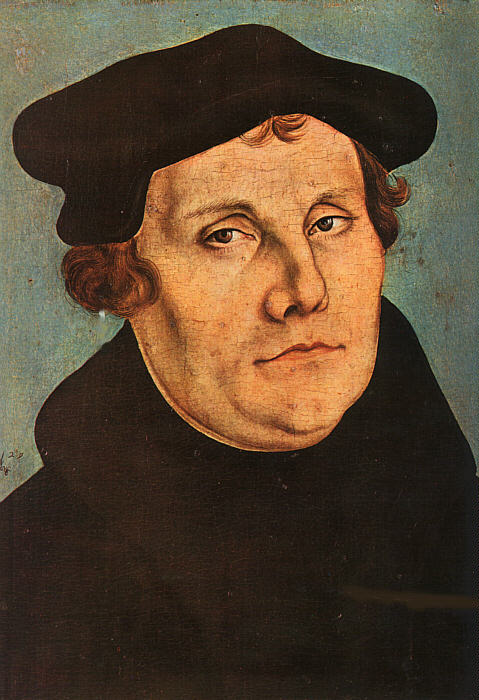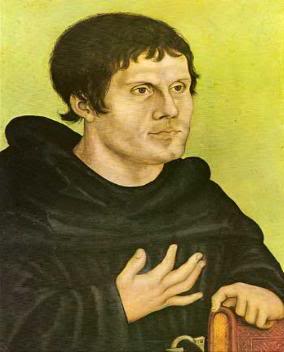Last summer 800 three foot high statuettes of sixteenth-century Protestant reformer Martin Luther popped up in the town square of Wittenberg in Eastern Germany. The red, green, blue and black figurines are the work of artist Ottmar Hoerl and were intended to replace a statue of Martin Luther on the town square while it is being renovated.The installation stirred a reproach from some Protestant theologians who say the statuettes, make a mockery of Luther’s achievements; but more likely opened up old wounds of a politically divided and fragmented Germany that spread to Europe and was the central battleground for the Thirty Years War of 1618-48.

---"My Luther statuettes look just like the original, except for the feet," Hoerl told German press agency DDP....Hoerl's art has caused controversy before. In 2009, he created 1,250 garden gnomes with their right arms outstretched in the Nazi salute. Read More:http://www.reuters.com/article/2010/08/11/us-germany-luther-idUSTRE67A3FH20100811
aaa
The ambivalence of Pope Leo X who fiddled while Catholicism went skyward in flames; his frivolty and ambivalence who refused to take Martin Luther seriously has never been forgiven. He presided over an intellectually intoxicated but emotionally emasculated church that was emotionally dead to the desire that stands at the core of a Christian response to god.
France was the most powerful kingdom of Leo’s and Spain was the most dynamic after its age old conflict with Islam. But the Holy Roman Empire, rickety and shattered as it was, remained in theory, if not in fact, the paramount power of Christendom. All in all, Leo was the spiritual father of a dangerous band of well-bred but hungry sovereign cannibals who were always careful to say grace before consuming one of their less powerful fellows.

Martin Luther, portrait, 1529 Uffizi by Lucas Cranach the Elder, Read More:http://linetap.com/trinity/tring2.htm
Leo was a statesman pope who sought to maintain the European balance of power and protect the political interests of the papacy in Rome. He operated on the time-honored premise that international issues are never soved but are merely replaced by more pressing problems; he adroitely negotiated the diplomatic course, always, it is said, “steering by two compasses.” For example, more time consuming and delicate of all his tasks, was that the papacy’s position in France had to be worked out to the satisfaction of both pope and king.
Leo conceived of the church as a vast, vulnerable and universal organization with revenues, real estate, offices, and prestige of every kingdom in Europe that could be protected only if the realities of power were recognized. Under these circumstances there was little time for humanistic propagandists nagging about ecclesiastical abuses, those trifling social and moral aberrations that invariably attach themselves to any venerable and comfortable institution. Germany had been fulminating against Rome for decades, and a pope could not be expected to listen to everyone who disliked paying taxes.

Horace Vernet (1789-1863) Raphael and Pope Leo X Oil on canvas Read More:http://www.artrenewal.org/pages/artwork.php?artworkid=3894
The world’s largest business could not be run without cost, both spiritual and financial. And anyone like the German humanist Ulrich von Hutten, who described Rome as ” the great barn of the universe, into which is garnered all that has been robbed and taken from other nations” and the pope as ” that insatiable cornweevil which devours piles of fruit, surrounded by its many fellow gluttons,” did his cause little good by such hefty expansions on the truth.
Moreover, as that fateful day in October 1517 approached, when a university professor, Martin Luther, would nail his defiance to a Wittenberg church door,his 95 theses delineating his reasons for leaving the Catholic Chruch. Still, there was a far more pressing and pleasurable matter to settle, the construction of that supreme monument to God in heaven and to Renaissance engineering and to good taste on earth: St. Peter’s Cathedral, the architectural e
iment of Leo’s image of the church militant: intricate, balanced and majestic. aaa
---An assistant walks between plastic statuettes of 16th-century Protestant reformer Martin Luther, which are part of the art installation 'Martin Luther - I'm standing here' by German artist Ottmar Hoerl. REUTERS/Fabrizio Bensch.--- Read More:http://artdaily.org/index.asp?date=8/12/2010
Leo called upon Raphael to submit new designs and act as chief architect. Raphael, with his usual immodesty made no effort to depreciate his plans., even asserting that the cost would amount to a million in gold. Money, of course, was the rub. Leo extended his tax raising efforts to include Portugal, most of France and large sections of Germany with the exception of the possessions of Albert, the archbishop of Mainz and Magdeburg, under whose ecclesiastical jurisdiction the city of Wittenberg was under. In 1515, however, Leo negotiated with Albert, a mutually agreeable understanding that has stood ever since as a baleful monument to everything that was wrong with sixteenth-century ecclesia.
The technical aspects of indulgences appear rather complex. Suffice it is to say that they were remissions granted by the Church of the temporal penalties of sin. They applied to both penance on earth and to punishment in purgatory, were granted in return for some good work- monetary or otherwise- and were originally issued for the benefit of those who went crusading on Christ’s behalf and fell in battle. Over the course of centuries the practice, if not in theory, became dangerously commercialized, until indulgences were regarded as a form of spiritual investment by the purchaser and a useful source of revenue by the church.
Both Leo and Albert were extremely interested to determine exactly how many florins could be squeezed from the faithful, both for St. Peter’s and Albert’s more secular interests to compensate himself and his family for holding three dioceses at once. The pope hesitated to sanction such a glaring example of pluralism, although he was not opposed to princely prelates in theory. But, ultimately politics swayed His Holiness. So, a bargain was arranged. After all, the Holy Roman Emperor could not live forever, and the election of his successor was of great political interest to Leo; the loyalty of two of the imperial Electors was certainly worth a slight stretching of canon law. So, Albert began selling indulgences in his territories for eight years: half to Rome and half to the Jacob Fugger banking house to pay his loan.
Almost no one in Rome seriously questioned the means or the ends of this amicable agreement. Kind of similar to the way very wealthy people turn over securities to university’s while retaining the use of the income. Such are the ways of the world. Everything was advancing nicely until Frederick of Saxony prohibited any selling of indulgences in his lands. But he was hardly an angel. In fact he was a competitor.
Frederick had gathered together one of the most spectacular collections of relics to be found in Europe. These included: four hairs from the Virgin’s head, fourteen scraps of her clothing, a wisp of straw from the manger, a stand of Christ’s beard, a nail from the Cross, and some 19,000 odd sacred bones, the whole of which, if venerated in the proper spirit and accompanied by a small monetary token, could cut 1.9 million years and 270 days from the pains of purgatory. So, we had here two rival and extremely profitable “spiritual crusades.”
What happened next is a rather insignificant university professor of theology with a sense of spiritual outrage matched only by the magnificence of his propaganda posted his Ninety-Five Theses on October 31, 1517, the eve of All Saints Day, the city’s principal holiday, when great crowds of pilgrims piled into the church to view the relics. With a single bang of the hammer Luther toppled forever the careful political schemes and considerations of Leo X.






 COMMENTS
COMMENTS